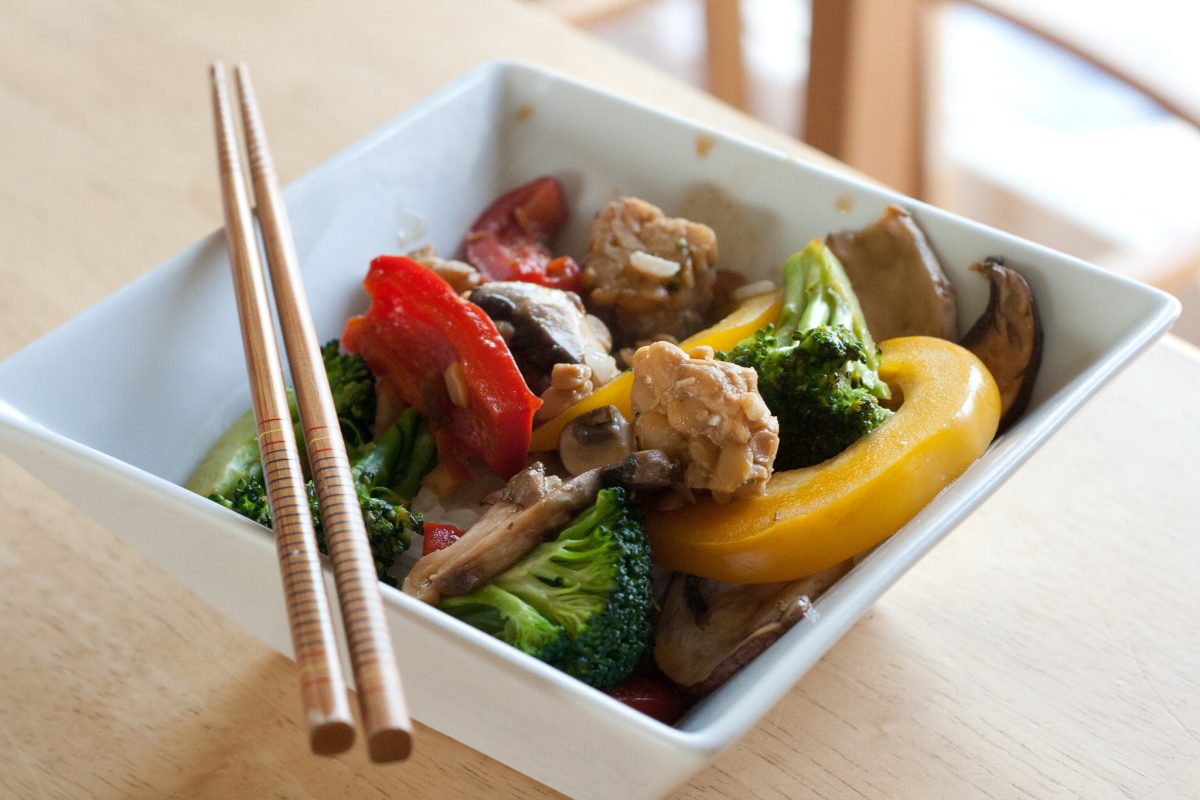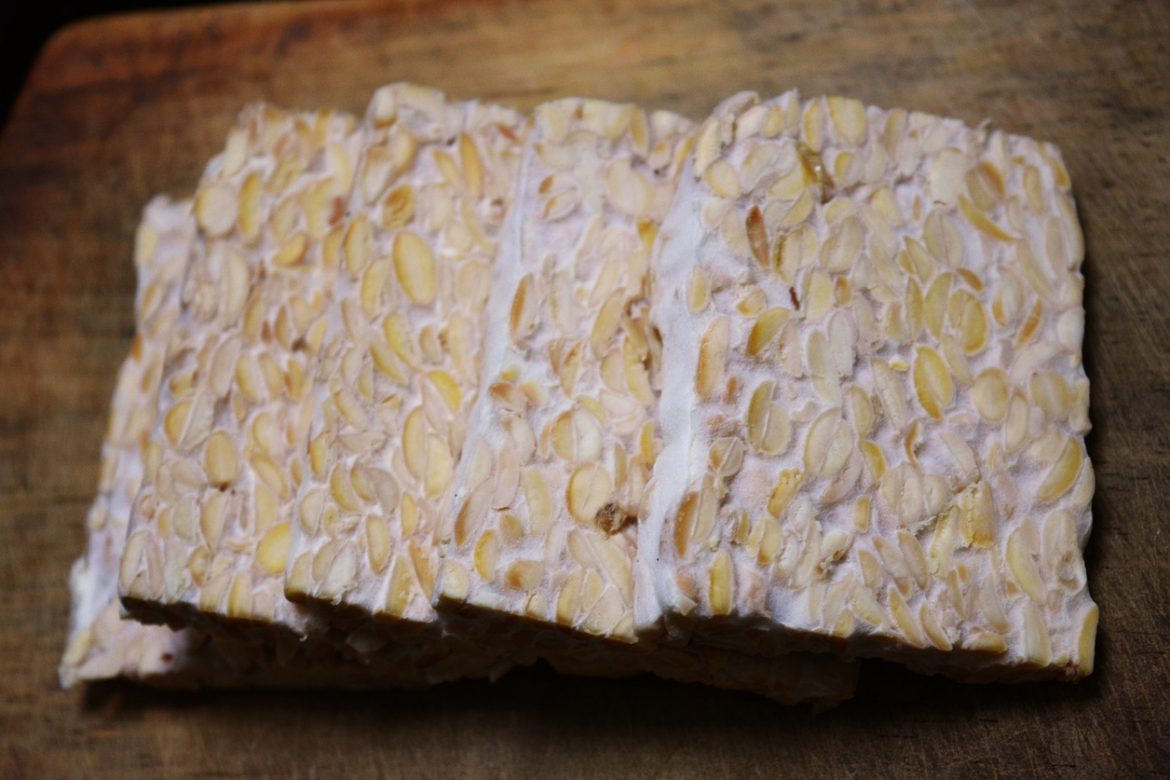Tempeh is currently one of the most popular meat substitutes in the market. Whether you’re vegetarian or not, it is a great addition to any diet. It’s very nutritious, contains prebiotics, is high in protein, and is also a versatile ingredient. Needless to say, it can rival tofu products any given day.
What Is Tempeh?
This traditional Indonesian food is made out of soybeans, which have been fermented. This is then pressed into a compact cake, closely resembling tofu, and is commonly consumed in the country as an alternative to meat as a source of protein.
That said, tempeh isn’t exclusively made out of soybeans. The most common varieties include:
- Soybean
- Lentils
- Chickpeas
- Soybean and wheat mixture
- Flaxseed
- Hemp seed
- Green beans
- Mung beans
- Cowpeas
FUN FACT:
Tempeh isn’t named after a specific kind of bean. The name is believed to have been derived from “tumpi,” which pertains to a classic Javanese food that’s made from rice flour.
What Does Tempeh Taste Like?
Quite unlike tofu, it has a very earthy flavor; some even compare it to the taste of mushrooms. When it comes to texture, it’s nutty and firm. Adding more flavor to it is a breeze, since it easily absorbs spices and sauces. Given its versatility, it can be used for various dishes, including stews, pastas, salads, chili, stir-fries, and so on.
Tempeh vs Tofu
Both tempeh and tofu are great meat alternatives, but there’s always the question of which one is healthier between the two. To better understand this, let’s talk about the similarities and differences of each.
Unlike tempeh, tofu is made out of coagulated soy milk that’s been pressed into blocks. Contrary to what some might believe, it doesn’t undergo the same fermentation process that tempeh does. When it comes to tofu’s texture, you can choose from silken, soft, and firm varieties. As for flavor, tofu is milder in comparison.
Tofu And Tempeh Nutrition Content
When it comes to nutrition, these two are very similar in certain ways. But, they also come with a number of notable differences. In terms of protein content, tempeh is the superior option. This is because it’s made out of legumes, seeds, nuts, and whole grains. That said, it does contain more calories, but is also rich in fiber. You might be wondering, then: is tempeh Ketogenic? You’ll be glad to know that it is, in fact, a good addition to your keto diet.
On the other hand, tofu is a bit lower when it comes to protein content. It also has less calories. Moreover, it is a great source of iron, calcium and potassium, however, with more than double the amount found in tempeh.
As for cholesterol? These soy products are both low in sodium and cholesterol-free.
Is Tempeh Healthy? Some Known Benefits
Both tofu and tempeh are rich in isoflavone content. These plant compounds can mimic the effects of estrogen, which can then boost both sexual and reproductive development. Did you know that both tofu and tempeh are known to reduce the risk of different cancers? They can also help with heart health—all thanks to their isoflavone content.
Tofu contains about 12-21 mg of isoflavones with every 85 gram serving. Tempeh has 10-38 mg with the same serving size, but this can vary depending on the size of the beans used in making it.
Tempeh vs Tofu: Prebiotic Content
Another distinct difference between tempeh and tofu would be their prebiotic content. Prebiotics are non-digestible fibers that help with the growth of healthy bacteria in your digestive tract. Its known benefits include reducing inflammation, regulating bowel movements, boosting memory, and lowering cholesterol levels.
Notably, tempeh is richer in prebiotic content. This is due to its fermentation process, and also because of its high fiber content.
Does Tempeh Make You Gassy?
If you have issues when it comes to gas or bloating, rest assured that tempeh will not trigger this. Despite the fact that it is made of beans, this soybean product is completely safe for people who have irritable bowel syndrome or IBS.
Is tempeh gluten free? Note that there are instances wherein a person might be sensitive to a component of tempeh, which can lead to bloating. Some varieties contain gluten because there are brands that add other ingredients, such as wheat, to enhance both taste and texture. If you have gluten sensitivity, this might cause you to bloat. Always check the packaging before you buy.
How Long Does Tempeh Last?
If you’re looking at an unopened package of tempeh that’s been kept in the fridge, it can last for about five days to a week past the sell-by date. One good way of prolonging its shelf-life is to avoid opening the package until you’re ready to use it. Meanwhile, if you have leftovers, make sure these are kept in airtight containers.
Placed in a freezer, with the package still unopened, tempeh can last for over 12 months. It can also remain viable past the year mark.
How To Tell If Tempeh Is Bad
You can tell tempeh has gone bad when it develops an unsavory odor. Furthermore, its texture would change, and it might even show traces of mold on the surface. Once you see these signs, it should be discarded.
Can You Eat Tempeh Raw?
For the curious, yes you can eat tempeh raw. That said, it may not be the most pleasant experience. Keep in mind that raw tempeh it is often coated with an oily mixture before it gets vacuum sealed. This gives the raw product an unpleasant taste. To remove this, make sure you steam it for around 20 minutes before serving.
Can tempeh be considered a raw food? This is subject to individual interpretation. The soybeans that comprise tempeh are cooked prior to processing, but after fermentationm not much will be left of them because of the tempeh culture. This culture pretty much eats away the beans and incorporates all of the amino acids and nutrients into the “soybean” cake.
This is why eating raw tempeh is also comparable to eating raw mushrooms.
Easy To Follow Tempeh Recipes
Think you’re ready to try out tempeh in your home cooking? Here are a few simple recipes to get you started off. Remember, this is a versatile product, so once you’re comfortable with using it, feel free to get creative!
Tempeh Salad With Tahini Dressing
Need to prepare a nutritious and filling meal, but only have a few minutes to spare? Try this 15 minute salad recipe.


INGREDIENTS:
- One block of tempeh
- 1/3 cup buffalo sauce (store-bought is fine)
- Olive oil
- One cup cherry tomatoes (chopped)
- Half a cucumber (sliced)
- Four cups of your favorite greens (we recommend arugula, romaine, and kale)
- Half a cup of carrots (shredded)
- ¼ cup onion (diced)
- Your choice of fresh fruit (we recommend dragon fruit, mangoes, and apples)
SALAD DRESSING:
- Two tablespoons of tahini
- ¼ teaspoon of garlic powder
- Juice of half a lemon (roughly one tablespoon)
- Salt and pepper
- Optional: water to thin out the dressing
DIRECTIONS:
- Start by cutting the tempeh into bite-sized sized pieces.
- Steam this for about 10 or so minutes, until it reaches the softness you want.
- Add olive oil to a skillet over medium heat.
- Cook this until it turns an even, brown color on all sides.
- Pour in your buffalo sauce and mix until it coats all of the pieces.
- Continue cooking for another minute or so, before setting it aside.
- Assemble your salad.
- Whisk your dressing ingredients together until everything is properly incorporated.
- Drizzle all over your salad.
BBQ Tempeh Burger
If you’re craving a smoky and juicy burger, but don’t want to eat meat, then tempeh burger is the best alternative. You can flavor it however you want and add any topping that suits your tastes.


INGREDIENTS:
- One 8-ounce package of tempeh (cut this into four pieces, roughly the size of a patty)
- ¼ cup soy sauce or tamari
- One teaspoon of garlic powder
- A cup and ¼ barbecue sauce
- One teaspoon of onion powder
- Two tablespoons of mirin
DIRECTIONS:
- Start by steaming the tempeh for about 15 minutes.
- Once done, plate and poke small holes on either side of each piece. Set aside.
- Combine the mirin, tamari, onion and garlic powder in a separate bowl.
- Use this mixture to marinate it for about half an hour to a full hour.
- Once the tempeh burger patties are ready, you can grill it for about five minutes.
- Another option is to fry-pan the pieces for about four minutes on each side.
- Once it turns a golden brown, that’s how you know it has been cooked well.
- Assemble the burger according to your preference.
Our recommendation: To bring out the flavors more, add sliced red onion, sliced tomatoes, sauerkraut, and sriracha vegan-mayo to your burger.
Tempeh Stir Fry With Veggies And Rice
For a quick yet delicious and nutritious meal, stir fry is your best bet. This dish can be tweaked according to your taste and you can toss in any leftover veggies you have at home. To make it more filling, add some fried rice to the mix!


INGREDIENTS:
- 1 package of tempeh (cubed)
- Two bell bell peppers (sliced)
- A cup or two of carrots (sliced)
- Four cups of broccoli (separated)
- One cup green peas
- Cabbage (chopped)
- One cup mushrooms (sliced)
- Two cups cooked fried rice
- Hoisin sauce (1 to 2 tablespoons for every bowl of stir fry)
- Two teaspoons sesame oil
- Salt and pepper to taste
Optional: chili flakes for extra kick.
PRO TIP: Since these veggies vary in hardness, some will cook faster than others. Always start with thicker veggies such as broccoli and carrots. You can add the rest as you go to make sure everything cooks evenly.
DIRECTIONS:
- Marinate your tempeh in two tablespoons of soy sauce and one teaspoon of garlic powder. Add pepper according to your taste.
- Heat up a wok or a large skillet over medium-high heat.
- Add this to your oil, the carrots, garlic, onion, broccoli, and seasoning.
- Cook the veggies for about four minutes or until the onions are soft.
- Add the rest of your veggies and cook for another five minutes. You would want your veggies to maintain some of its crunch. This will make them even more appetizing!
- In an oven, cook your tempeh for about 10 minutes or until it becomes crispy. You can also opt to fry it separately instead.
- Plate the veggies and serve with a scoop of fried rice. Serve the tempeh on top and drizzle with hoisin sauce.
Simple Tempeh Meatballs
Tempeh as meatballs? It might seem strange to some, but best believe it is absolutely delicious. Not to mention it’s really healthy as well.


INGREDIENTS:
- Three cloves of garlic (minced)
- ½ cup of onion (minced)
- Two eggs
- One pack of tempeh
- 1/3 cup of parmesan cheese (you can also use a vegan option)
- Two teaspoons of Italian seasoning
- Half a cup of bread crumbs (almond meal for a gluten-free alternative)
- ¼ cup of fresh parsley
- Olive oil
- Two tablespoons of your favorite tomato sauce
- Salt and pepper
- Extra breadcrumbs and parmesan cheese (for coating)
DIRECTIONS:
- Preheat your oven to about 375 degrees.
- In a pan, sauté your onion and garlic together in olive oil. Do this until they turn translucent and soft.
- Take out your food processor and add your tempeh to it. Pulse until it turns into a crumbly powder. You can use your blender for this purpose as well.
- Next, add your garlic and onion, as well as the rest of the ingredients (except for the oil) into the mix. Pulse until you get a dough-like texture.
- Taste before adding your seasoning. Tempeh will likely have a slight bitterness. This will decrease once it has been baked and mixed with other sauces.
- Take the dough and roll it into balls. Adjust the size according to your preferences.
- Coat the balls in breadcrumbs and cheese.
- Brown the tempeh meatballs in a hot skillet.
- Once the pieces are evenly browned, transfer it to the oven. Bake for about 15 minutes.
- You can remove them from the oven once they’re firm to the touch and have a nice golden brown color.
Your tempeh meatballs can now be used for sandwiches, pasta, and soups. You can even eat it on its own!
We hope these tempeh recipes helped you better understand the versatility of this soybean product. Don’t be afraid to experiment! Once you know how to cook tempeh, you’ll be able to get really creative with the dishes you make.


